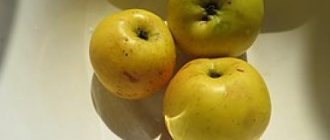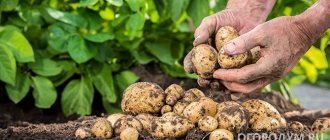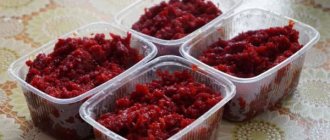Preparing the premises?
In order not to lose the precious beet harvest and provide yourself with useful vitamins throughout the winter, you should take into account a lot of nuances and recommendations for proper storage of beets in the cellar.
Make sure that the cellar has a sufficiently high degree of ventilation , and cool air moves freely around the entire perimeter. Install bins for root crops 10-15 cm above floor level for better airing.
The floor, walls and other surfaces must be cleaned and dried from excess debris. To be on the safe side, bleach is sometimes used and whitewashed for sterilization .
Deadlines
Even at room temperature, beets can be stored for about a week . Thick skin prevents rapid loss of moisture. Keeping the root vegetable in the refrigerator, in a plastic bag, extends the shelf life to up to a month.
Sprinkled with sand, sawdust, ash and chalk shavings, as well as treated with a clay mash, vegetables can be stored for about four months if placed directly in the room.
And until the next harvest, if placed on a glazed balcony. Provided that the temperature conditions are observed and the air humidity meets the requirements. The material about the proper preparation of carrots for storage for the winter will be interesting.
To increase the shelf life of beets, you need to sort through the vegetables from time to time. Remove spoiled fruits from boxes and bags. You shouldn't do this too often. The skin may be damaged. When storing in the refrigerator, condensation must be prevented.
Storing beets in plastic bags , in bags for the winter, as well as how to store beets without a cellar further.
Features of Shared Storage
Now let's figure out how to store carrots and beets for the winter in a cellar or basement, without harm to the vegetables. Both types of root crops cannot tolerate too much humidity and are vulnerable to freezing. If beets can be safely placed in one box along with potatoes , then carrots should be kept separately and in a slightly different environment.
For it, it is better to “layer”, successively changing the layers of sand and carrots in the container. Sand for carrots should be saturated with moisture by 20-35% . Occasionally they resort to treatment with liquid clay, which will serve as an extra layer of protection for the vegetables.
Like most products intended for long-term storage in the cellar, beets will acquire another protective covering if they are rolled in ash or chalk chips. It is recommended to sift the wood ash well before doing this.
Place
A well-known place for storing vegetables is the underground of a house or, in common parlance, a basement . But not every apartment building has space in the basement. Allocated to residents for personal use.
People have tried different places to store vegetables. The most popular of them: glazed balcony, stairwell, storage room, space under the bed .
You can also store beets simply in a box in your room or in the refrigerator. Read about storing carrots in and without a cellar here.
But the last two options can only be considered if long-term storage is not planned.
Read on to learn about the main features of how to preserve beets and carrots at home.
Terms and Conditions
Choosing a variety
So, raising the topic of how to store beets in the cellar in winter, it is worth taking a responsible approach to choosing a variety, because the further success of the entire process depends on this. The following varieties are considered the most resistant to cold and long-term storage : “Red Shar”, “Renova”, “Podzimnyaya”, “Gribovskaya Ploskaya A473”, “Mulatka”, “Nosovskaya Ploskaya”, “Bravo”, “Incomparable”, “Bordeaux 237” ", "Libero", "Single-germ", "Pablo F1".
Most often these are mid-season, late species. grown on fertile soils, especially sandy and loamy types, will feel good in They are less likely to suffer from disease and erosion, such as cracks and growths such as those caused by scab.
Carry out a thorough sorting of vegetables , carefully choosing only whole and undamaged fruits - viral or fungal diseases can easily develop in ulcers and depressions.
Any suspicious specimens should be destroyed , for example, if voids were found in the pulp, and black hardened areas were found on the sides. It will be very convenient to sort beets by size - store small products separately from medium ones, etc.
Avoid root vegetables that are too large or too small. Focus on the taste of future winter stocks: , not too fibrous or hard beets for storage in the basement If, while growing beets, you actively fertilized them with phosphorus and nitrogen, then there is a small chance that white or gray rot will appear on them during storage.
How to prepare?
For storing beets for the winter in the basement, a fresh harvest that has just been harvested from the plot is suitable, so as soon as you have collected the vegetables from the garden, start preparing. To begin with, all the fruits will need to be thoroughly cleaned of lumps of earth . To make this process easier and faster, the root vegetables can be placed in the sun for a short time - after warming up under the rays, they will soon dry out.
Under no circumstances should you bother washing the beets - leave them with a natural protective layer of a thin earthen film. It is convenient to clean beets with dry wipes or a towel.
Prepare with gardening gloves and scissors or a sharpened knife. Leave the tails of the vegetables as is, and carefully cut off the tops, leaving literally 1-1.5 centimeters.
The next step will be preliminary storage in a dark and dry place with good access to fresh air. So, beets can be kept in a barn outbuilding , utility room or attic for about a week.
Of course, in sunny and dry weather, vegetables can be left to dry there, on the beds, for which a couple of hours will be enough. Storage indoors takes longer, but is safe - you don’t have to worry about the fruits getting damp, being eaten by insects or getting caught in the rain.
Once the beets are completely dry, they are ready for extended winter storage.
The main point in the question of how to preserve beets for the winter in the cellar for a long period of time is their short treatment with a weak saline solution. After all, it will become an additional protection for beets from harmful influences. After keeping the root vegetables in this solution for a couple of minutes , they must then be dried in the sun.
For the saline solution needed for processing beets, one or two tablespoons of salt are consumed per liter of water. This is about 200-250 grams.
What is the best way to store it?
Of course, it is much easier to use a regular mound and store root vegetables on the floor, but this way they will be deprived of full access to air and risk molding. Use spacious bins with fairly high walls (up to 1 m), through the boards of which the beets will not fit.
For the pallet, also choose a wooden covering with gaps. The bins should not touch the walls of the room - it is best to place them at a small distance.
The advantages of such fences over plastic bags and baskets are that the air inside circulates easily, and you don’t have to worry about excess moisture spoiling your supplies . Some expert gardeners insist on cutting off the side roots along with the tail. This way, crop owners only increase the risk of introducing infection through cut areas. Try to save the beetroots unless they are too long.
Deadlines
The standard storage period is considered to be 7-9 months . By covering the beets with sand, you will increase this time to a year. This is subject to all the rules of thoughtful storage.
Choosing a beet variety for storage
Thanks to the efforts of breeders, today there are many varieties of beets that differ in taste and other characteristics. The shelf life also depends on the variety, so you need to carefully choose the most suitable one, otherwise the fruits may begin to wither and rot.
The following varieties of beets are considered the most common for storage:
- Red ball;
- Bordeaux;
- Late winter;
- Egyptian flat;
- Libero.
There are many varieties of beets.
The Cylinder variety is also often used for these purposes, but it is considered extremely finicky. To store the Cylinder, maximum compliance with all conditions is required, otherwise the vegetable begins to quickly deteriorate.
Storage methods
Now that you have become familiar with some of the nuances of how to store beets in the winter in a basement or cellar, it’s time to move on to the most popular storage methods. One of them is storing vegetables in sawdust. A loose layer of shavings and sawdust is placed at the bottom of the box , then a layer of beets, sawdust again, and so on until the box or bag is filled.
It is important to periodically monitor whether the protective material for root crops has become damp, and then be sure to replace it with a new one. Now, you know how to store beets in the winter in a cellar or basement using sawdust and sand.
For storing beets in sand, see the photo below.
Another storage method is based on the use of sand. All beets are loaded into large wooden boxes or thick baskets, from medium to larger specimens.
Afterwards, the fruits are completely covered with sand. For these purposes, it is best to stock up on river sand so that you can occasionally replace too damp sand with fresh sand.
It is very convenient to store beets in thick plastic bags. The main thing is not to add too many fruits so as not to tear the packaging. The optimal weight for each batch will be approximately 35 kg of beets.
Bags of vegetables in the cellar are always left open so that the beets do not “sweat” and rot. At the same time, you can add sand, peat or soft wood shavings to them.
If you decide to store beets in the open, then the help of some plants like fern, oak or pine will not hurt. Their leaves are rich in phytoncides, which reliably destroy some harmful microbes and parasitic fungi.
So, by laying fern leaves under the beets and also covering them on top, you will protect the crop from some pathogens of plant diseases.
Table salt will give almost the same protective effect. To do this, just lightly sprinkle all the beets with a small amount of salt.
If it is not possible to build bins , use wide shelves or racks. All the beets are placed in a stable heap on them.
Harvest
The shelf life of a vegetable can be affected by the harvesting process. The root crop is located underground, so you need to choose a day when the weather is warm and sunny.
Important! If the fruit freezes, the damaged area will begin to deteriorate, and storing the vegetable will be problematic.
The collection technology itself is also important. You need to do all the work as carefully as possible so as not to damage the root crop. Using a pitchfork or shovel, carefully dig up the soil under the vegetable and just as carefully pull the root vegetable out of the ground by the tops.
In this video you will learn more about storing beets:
Selection of root crops and preparation for storage
Growing and harvesting root vegetables correctly is only half the battle. You should know how to properly prepare beets for storage so that they remain fresh for as long as possible and enrich your diet.
Stages of preparing beets for winter storage:
- Cleaning . Vegetables must be freed from lumps of soil. At the same time, you should not knock or remove dirt with a brush or knife; this can damage the skin, which will provoke the development of infections that will not allow the crop to be stored for a long time. It's better to do this with fabric gloves.
- Drying . If the weather is sunny, then the beets can be left in the garden for 2-4 hours to dry. In this case, direct rays of the sun should not fall on the root crops. On a cloudy day, the crop should be dried under a canopy or indoors. The procedure takes from 3 to 7 days. When starting drying, it is important to leave some distance between the root crops to ensure free access of air for ventilation.
- Tops trimming . Do not twist, break off or tear off the tops; it is recommended to use a knife or scissors and make even cuts, leaving a tail 0.5 to 1 cm long.
- Root removal . It is important to remember to remove the fine fibrous roots from the surface of the beets. If the main rod is long, it must be shortened to 5-7 cm. The sections must be dried.
- Sorting . Only smooth, medium-sized root crops with dense and thick skin, without mechanical damage or various defects, should be stored for storage. Rejected vegetables can be used immediately: canned, rolled into jars, frozen, chopped into small pieces.
It is not recommended to wash beets, otherwise they will quickly become unsuitable for storage.
How to properly store beets in the cellar
Beets will keep well in the cellar if you sprinkle them on top of the potatoes. But if this method does not suit you, there are several other reliable methods.
How to store beets in bags
Remove the vegetables from the butts and dry thoroughly in the fresh air. The cut areas should be tightened. But make sure that the beets do not lie in direct sunlight for a long time.
Place root vegetables in heavy-duty plastic bags, deflate and seal. You can additionally sprinkle the beets with pine sawdust, although they are well stored without this.
How to store beets in boxes
Cut off the tops of the beets, leaving about 1 cm. Then dry the vegetables in the fresh air and remove the soil.
Place 2–4 cm of pine sawdust, sand or moss on the bottom of wooden or plastic boxes. The filler must be dry.
Spread the root vegetables on top in one layer at a short distance from each other.
Cover the vegetables with the filling.
Repeat layers until you run out of beets. Sprinkle a thick layer of filler on top.
How to prepare the storage?
Proper preparation of the cellar room should include high-quality waterproofing and air venting so that optimal humidity and temperature are maintained.
When arranging through holes, protection against rodents must be provided. The purpose of waterproofing is to prevent possible flooding by groundwater and rainwater.
This point must be taken into account at the stage of creating the structure. For example, organizing a good drainage around the perimeter of the building .
Before placing a new crop in the cellar, the room should be inspected and, if necessary, repaired and ventilated. It is also important to remove the remains of last year's harvest and debris. If necessary, treat with bleach for sterilization.











